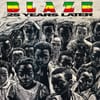The Conceptual House Album That Tells the Bittersweet Story of Newark’s Post-Civil Rights Era
The New Jersey trio Blaze’s singular 1990 record ‘25 Years Later’ wrestles with the unfulfilled promises of Black liberation.

For decades, Black musicians have reached for the canon of Black dance music in moments of political crisis. In the early 1980s, amid an economic downturn, the brutal repression of Black radical struggles, and the arrival of a major right-wing turn in American politics, soul and funk artists like Fatback and the Valentine Brothers wrapped pointed rejections of Reaganomics into punchy synth-funk and boogie tracks that reworked the hallucinatory 1970s work of Funkadelic and Sly Stone. D’Angelo mined those same ’70s grooves on his 2014 album Black Messiah, released in the wake of the Ferguson, Missouri protests that took place after the police killing of Michael Brown. More recently, Beyoncé leaned toward escapism and archiving during the COVID-19 pandemic and the global recession that accompanied it with Renaissance—experimenting with a variety of dance music styles to, as she put it, “feel free and adventurous in a time when little else was moving.” Around the same time, the heartracing pulse of Jersey club became the de facto tempo of so much rap and pop, soundtracking a stir-crazy post-pandemic era.
As we enter another moment of growing alienation, unprocessed grief, and fears of backsliding civil rights, I’ve been drawn back to a forgotten gem of political Black dance music that deserves a place in this canon: 25 Years Later, the 1990 debut album by Newark, New Jersey house trio Blaze. Released on Motown Records, 25 Years Later holds an unusual place in the genre’s history: It captures the nuances of Newark’s distinct take on house within a strikingly ambitious concept album—using the sound and style of the city’s nightclubs to ask complex questions about the end of the Civil Rights Movement.





